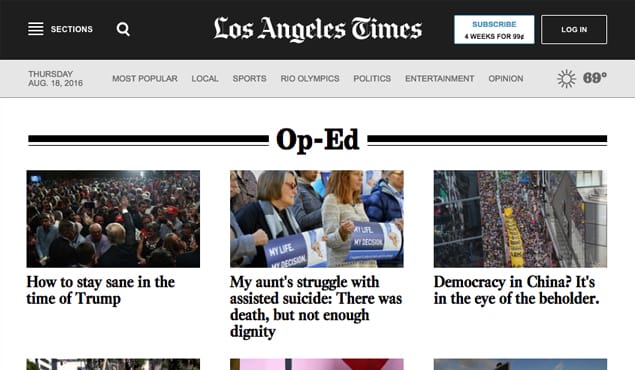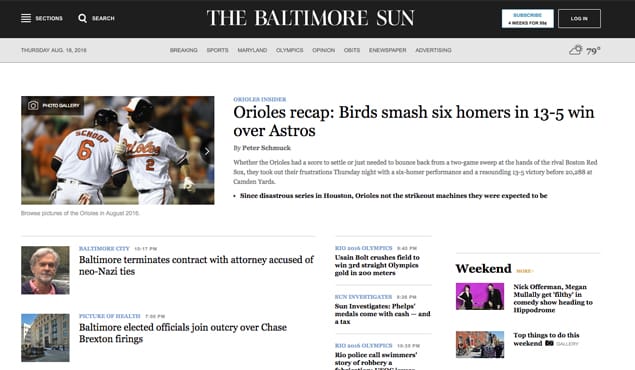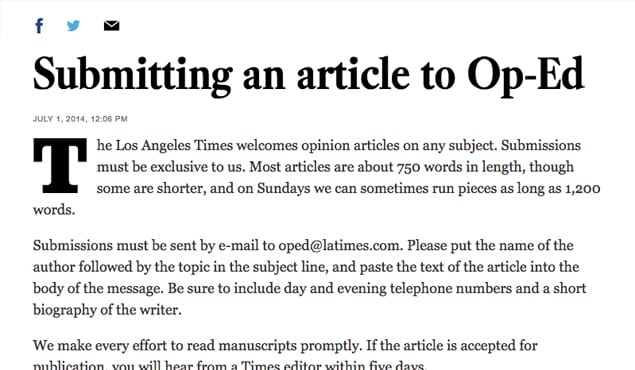The Op-Ed is a time-honored tradition in the magazine and newspaper industry dating back to the sepia-infused ages of 1970. Well, quite a bit before that if you consider that the original “Op-Ed” meant anything opinionated (as opposed to factual) written by the editorial staff that appeared on the opposite page of the Editorial column of a newspaper.
Semantics and origin-stories aside, the Op-Ed today stands as one of the most powerful and frequently read columns in any publication. Most major newspapers have Op-Ed columns, which means the website version of those newspapers also have them, which in turns means all major websites that don’t have physical newspapers also have them, or are entirely composed of them.
And you want to write one. Good for you. Get ready for a host of rejected submissions and a highly detailed account of your reasons for belief.
What is an Op-Ed?
An Op-Ed column has one universal requirement: an opinion.
Not to be confused with your standard “what happened, how it happened, why it happened” news report, an involved study, or an interview, the Op-Ed is high quality, pure grade opinion.
Now, pretty much everyone alive (and writing) has an opinion of some kind. This means, in theory, everyone has an Op-Ed piece inside them just waiting to hit the presses.
When looking at submitting an Op-Ed article to a major website you’ll need to remember that there are a number of factors that will determine your acceptance. Some of these factors are in your control, others are not. This article will teach you the basics of submitting Op-Ed pieces with the goal and hope of acceptance, but I’ll be frank with you — it ain’t easy. Even well-known authors get Op-Ed pieces regularly rejected.
I’ll break down the different avenues to take for submitting the Op-Ed below, and include the caveats of each step.
Creating the Op-Ed Article
Let’s start with the actual start of any article process — what do you want to write about?
Remember that Op-Ed articles need to be based on your opinion. This means you’ll need to take a stance on something. This in turn means you’ll need to have a specific something to take a stance on.
Getting Specific
Like this article is about a specific subject, any good submission and acceptance process will start by narrowing your subject to an extremely fine point.
Remember, there are countless of people submitting every day. Having a generic subject, like trees and what they mean for the earth, is probably too broad.
If you wanted to talk about a specific kind of tree and its importance to a particular culture on earth, that would be narrowing it down. Better yet, what a particular grove of trees during a 300-year period of time for a small, peaceful society could do for the world.
Those are fake topics I just made up, so don’t go searching for the grove of trees.
The point is that you’ll need to get really specific.
Be Relevant
A major factor of the Op-Ed column is that its relevant to what’s going on. There are certainly Op-Eds that aren’t laser-focused on a time-based event or issue — also called evergreen content — but the reality is that most Op-Eds are written in the fray of the most recent news.
This means that you’ll be competing with other writers in your field, all of which are pounding the pages in the aftermath of an event.
To illustrate this, I think of the recent violence in the U.S. and the Black Lives Matter movement. The Op-Eds that deal with those subjects are written in the recent aftermath of protests and videos. Sure, longer, more studied articles about it come out over time, but the Op-Ed grabs the reader for its opinions of a relevant topic.
Bring Your Opinion to an Opinion-Worthy Topic
The above example (of a grove of trees) would not be a very good Op-Ed topic because that grove of trees is not likely to be known, understood, and debated by the general populace.
Along with time-based relevancy, a great Op-Ed addresses issues that are spliced into the vein of popular culture, whether it’s politics, religion, war, technology, or the environment, or many more.
Don’t be limited with scope, but remember that for you to have an opinion that matters, there have to be other opinions on the subject. A grove of trees may be very interesting, but where’s the electricity in the subject? Where’s the charge?
The U.S. political cycle is charged. Go look up some popular op-ed articles on that, and you’ll see what I mean.
Your Opinion Matters
Contrary to what people may think, you can strongly believe in any part of an issue, write an opinion, and potentially get it published.
It’s important to understand the Op-Ed article generation process, specifically your opinion, because it will greatly influence who is willing to take your article.
You could travel the reverse route — that is, pick an institution you’d like to publish with, narrow in on a popular topic, and then form an opinion that suits their typical readership.
This is a bit dicey because it implies you have an opinion that is curated by the magazine’s desire, which is precisely what an Op-Ed is not.
An Op-Ed is your actual opinion. So give it.
Write the article and then begin your next phase in the long chain of submitting an Op-Ed article to a major website.
Assuming you’ve already picked the topic (and written the article), it’s time to start narrowing in your institution.
Know Your Audience
Hopefully you’re a writer with some knowledge of the market. You should have a general idea of what magazines, newspapers and websites typically publish in terms of genre and political bent.
If you don’t know, begin this quest by going to the front pages of all the websites you’d like to write for.
Sites like The New York Times, Wall Street Journal, Washington Post, Huffington Post, Boston Globe, etc. etc., are good places to start.
Many of these institutions cover a huge range of topics, and tend to support multiple opinions. Granted, those opinions are usually couched in the overall political tone of the paper, so if you’re ultra left-wing in your approach don’t send your Op-Ed to The Hill — it probably won’t be published.
Aim High, Then Aim Low
Unless you’re a person of note or interest in the public eye, it will be more difficult for you to get an Op-Ed published at a newspaper like The New York Times. You can do it, but don’t garner any expectation of doing so soon (or ever).
It’s great to submit to the cream of the crop, but you should also be looking at smaller newspapers, magazines and websites so you can begin to build a name as an Op-Ed writer.
Start by looking at websites in your niche. If you’re writing an Op-Ed on the U.S. election, the sky’s the limit on the types of publications that could pick up your writing. If you’re writing an opinion on use of fluoride in toothpaste, your websites become more focused.
After thinking about niche, think about location. If you’re an author based in a specific city or state or country, that gives you a certain opinion to start out with. Then, if you have an opinion on a topic that a magazine or website covers in your area it’s a double-whammy.
You become a local author with an opinion, which resonates with local readers. This matters somewhat less for websites that have no real location, but a lot of traditional newspapers still have offices.
You don’t want to aim so low that you’re getting published on websites that aren’t taken seriously, but you’ll need to have a spreadsheet that lists your first, second, and third tier publications.
Start reaching out to all of them.
Contacting the Institution
After getting a great topical piece of content that is dripping with your opinion, assembling a collection of newspapers and websites you want to submit to, you’ll need to do the actual submitting.
This step in practicality is fairly easy. The difficulty comes in moving from a submission to a published article.
First, though, the submission.
Submitting Your Op-Ed
You’re in luck — there’s an amazing resource out there created just for this purpose. The Op-Ed Project is going to be your best friend when it comes to researching specific websites, how to’s, and other aspects of the Op-Ed world.
The most immediately helpful part of the website is the long list of publications that is has collected for you. The site has over 125 publications listed, each with a small paragraph about what the organization does, what they typically accept, and who the editor is at any given time.
The editor is not always listed (because the info is not always available), but The Op-Ed Project does the best job it can in giving you the information quickly and easily so you can be on your writerly way.
The best part of this for submission purposes is that editor’s name (when listed), and the email address to actually submit to.
This is golden.
Easier Submissions Than Other Kinds of Articles
One of the differences between the Op-Ed editorial inbox and other features of a newspaper is that the Op-Ed team needs opinions, and it needs them fairly quickly.
This means that if you write on a hot topic, get your submission in quickly, and have a great article, your chances of actually getting a response (and publication) are better than other categories of publication.
With that said, the odds of you — a no-name author with a viewpoint — getting accepted to The New York Times on your first try is very, very slim.
Often the largest publications will have Op-Ed authors slotted on given subjects. Yes, they skim the inbox, but it’s a bit like a slush pile. Those massive publications don’t have the time to read through everything, and they definitely don’t have the time to respond to everything.
Remember, also, that if your website is not on the list by The Op-Ed Project, many newspapers will have a specific email listed for Op-Ed articles, or state that they don’t accept blind submissions. You can always email a Contact email address to ask.
Your Email Pitch
The above means you want to frame your Op-Ed pitch extremely well, and briefly.
This includes:
- Who you are
- What your topic is
- What your opinion is
- Why all of that is important to readers
Again, The Op-Ed Project has great guidelines for your pitch, but you’ll want to include all of that in clear, concise writing. After that, paste the whole of your Op-Ed below, and send it off.
This is very different than other pitch processes, mostly because of the general anonymous aspect of the Op-Ed process, and how timely it has to be.
Your Credentials
I think the four bullets above are all fairly clear, but wanted to note the credential aspect of your Op-Ed pitch.
First, you don’t have to be famous, have written a ton of articles, or be Hunter S. Thompson to get published. However, all of those things will help you a great deal, and they help lots of people who are penning Op-Eds.
Barring actually being Hunter S. or a legitimate celebrity, your most consistent competition will be other authors with a decent track record of publication. Most authors today are not famous — they have bylines and know how to write and publish weekly in some local or international publication.
If you’re writing an Op-Ed and have no previously written work, this will be a point against you. What following do you have, and what previous skill have you demonstrated?
Most importantly, why is your opinion valid?
I could pen 1,000 words on why I think corporations should give employees a 30-hour work week option, but what exactly are my qualifications for believing this? Have I conducted a massive study of corporate society and social systems? Am I professor that teaches in the subject? What validates my opinion?
You’ll want to address this in your “Who am I” section of the email, because not only should the opinion in the Op-Ed be unique and fascinating, but it should carry some weight.
Follow Up
If you’ve sent out your Op-Ed to a publication, make sure to follow up in a reasonable amount of time. This timeframe is different than other types of pitches.
If your Op-Ed is particularly grounded in a current event, you’ll want to follow up in a day or two with the editor, asking if they have had a chance to review your article, as you want to send it out to more publications if they are not interested.
They should get back to you.
For an evergreen Op-Ed, wait a week or so.
Either way, use the follow up to try to get a response from the editor. Once you’re in a dialogue, it will be easier to remain recognizable to them in the future.
You want to get on the radar of these editors so that, eventually, when you write the right Op-Ed for them they will know you, scoop it up, and put your name in print.
Also, be aware that the national newspapers won’t consider your Op-Ed if you submit to more than one place at once.
Write Away
An Op-Ed article is a great goal for publication. If you follow the above steps, work hard, and build a collective of bylines along the way, there’s a good chance you will get published on a major website.
Remember that the trifecta of the Op-Ed writing storm is a powerful opinion well expressed, a topic that inspires contradiction and a reason to read your words. Get each of those pumping and you’ll be set.
 ContentPowered.com
ContentPowered.com











Scott McLain
says:Thank you for publishing a very informative how-to. Question- Would you recommend that rejected pieces be published on the writers personal site/blog? And would that help enhance the writers credibility on future submissions?
James Parsons
says:Hi Scott! I’ve done this in the past, actually. As long as the article is still current, I don’t see any harm in re-using it if it’s been a month or so without a reply from the publisher you’re contacting. It’s just unfortunate when you write a more timely / news piece and it becomes irrelevant and unusable after a week or two. As long as it’s evergreen and still relevant, you should pitch it to other publications!